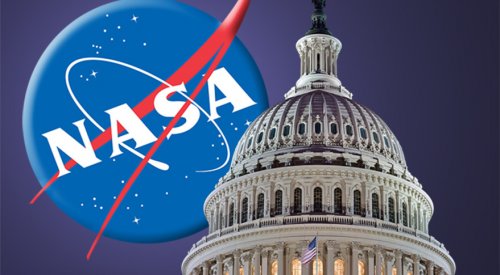WASHINGTON — The White House’s fiscal year 2018 budget proposal seeks to cancel five NASA Earth science projects and confirms plans to shut down the agency’s education office as part of more than $560 million in cuts from 2017.
The proposal, released May 23, offers $19.092 billion for NASA, $561 million less than what the agency received in a fiscal year 2017 omnibus spending bill enacted earlier this month. That amount matches values in a leaked spreadsheet last week, indicating cuts to NASA science, exploration, space operations and other major accounts.
“At $19.1 billion, we have a very positive budget that retains the same parameters we saw in March, and which reflects the president’s confidence in our direction and the importance of everything we’ve been achieving,” NASA Acting Administrator Robert Lightfoot said in a statement.
The budget proposal includes $1.754 billion for NASA’s Earth science program, a cut of $167 million from what it received in 2017. Administration documents noted that included a savings of $191 million by cancelling five Earth science instruments and missions deemed low-priority.
“The proposed termination of these five missions restructures the NASA Earth science portfolio within the available budget in a way that causes the least impact to NASA’s ability to execute a balanced, comprehensive Earth science program that meets the highest priorities of the science community,” the White House Office of Management and Budget (OMB) said in a document outlining overall reductions in the federal budget request.
The White House identified four of the projects in its budget blueprint, issued in March: the Plankton, Aerosol, Cloud, ocean Ecosystem (PACE) satellite, the Climate Absolute Radiance and Refractivity Observatory (CLARREO) Pathfinder and the Orbiting Carbon Observatory (OCO) 3 instruments for the International Space Station, and Earth-viewing instruments on the Deep Space Climate Observatory (DSCOVR), launched in 2015.
The fifth project, not previously mentioned, is the Radiation Budget Instrument (RBI), which would have flown on a future weather satellite to measure the Earth’s reflected sunlight. The measurements RBI would have made can be provided by other existing and planned missions, the document stated, adding that RBI has also experienced cost growth.
The budget also includes plans to close NASA’s Office of Education, providing $37.3 million for closeout and transition costs. “The Office of Education has experienced significant challenges in implementing a focused NASA-wide education strategy, including challenges in providing oversight and integration of Agency-wide education activities,” the OMB document stated. It added that what data that was available about its activities “has been insufficient to assess the impact of the overall Office of Education portfolio.”
“There are still some hard choices that we had to make,” Lightfoot said in a “State of NASA” speech at NASA Headquarters May 23. “We just can’t do everything that we want to do, but we can do a lot.”
Other reductions in the budget request were planned. Declines in funding for the James Webb Space Telescope and commercial crew programs in the 2018 request match past projections for reduced spending for them as they approach completion.
Some programs got increases. Planetary science, which received a record-high $1.846 billion in 2017, would get $1.93 billion in the request. That includes $425 million for a Europa orbiter mission, but with the provision that the money not be used for a follow-on lander.
“The budget provides no funding for a multi-billion-dollar mission to land on Europa that was not in the last Decadal Survey and would send another flagship mission to Europa before analysis of the Europa Clipper data is completed,” a NASA budget document stated, referring to the 2011 planetary science decadal survey that did not identify a lander mission among its highest-ranked large, or flagship, missions.
The budget confirms plans to cancel the Asteroid Redirect Mission (ARM), while retaining some of its key technologies. “While we ended the Asteroid Redirect Mission going forward, we will take those technologies, with solar-electric propulsion as probably the best example, and move forward with them and morph those into a different mission,” Lightfoot said in his speech.
Lightfoot emphasized in his address the overall continuity in the budget request, which continues major science and human spaceflight programs with modest funding changes. “What this budget tells us to do is keep going, keep doing what we’ve been doing,” he said.
Budget Proposal (values in millions of dollars)
Account
FY17 Omnibus
FY18 Request
Difference
SCIENCE
$5,764.9
$5,711.8
-$53.1
– Earth Science
$1,921.0
$1,754.1
-$166.9
– Planetary Science
$1,846.0
$1,929.5
$83.5
– Astrophysics
$750.0
$816.7
$66.7
– JWST
$569.4
$533.7
-$35.7
– Heliophysics
$678.5
$677.8
-$0.7
SPACE TECHNOLOGY
$686.5
$678.6
-$7.9
AERONAUTICS
$660.0
$624.0
-$36.0
EXPLORATION
$4,324.0
$3,934.1
-$389.9
– SLS
$2,150.0
$1,937.8
-$212.2
– Orion
$1,350.0
$1,186.0
-$164.0
– Ground Systems
$429.0
$460.4
$31.4
– Exploration R&D
$395.0
$350.0
-$45.0
SPACE OPERATIONS
$4,950.7
$4,740.8
-$209.9
– ISS
$1,490.6
– Space and Flight Support
$835.0
– Commercial Crew
$1,184.8
$731.9
-$452.9
– Crew and Cargo
$1,683.2
EDUCATION
$100.0
$37.3
-$62.7
SAFETY, SECURITY, AND MISSION SERVICES
$2,768.6
$2,830.2
$61.6
CONSTRUCTION
$360.7
$496.1
$135.4
INSPECTOR GENERAL
$37.9
$39.3
$1.4
TOTAL
$19,653.3
$19,092.2
-$561.1
- NASA examines effects of 2017 spending bill on science programs
- NASA’s Deep Space Network could face telecommunications traffic jam on Mars
- The Moon is the gateway to NASA’s exploration future
- NASA receives more than $19.6 billion in 2017 omnibus spending bill
- Earth scientists are freaking out. NASA urges calm.
Share with your friends

(0) Comments
This article comments are currently no :(